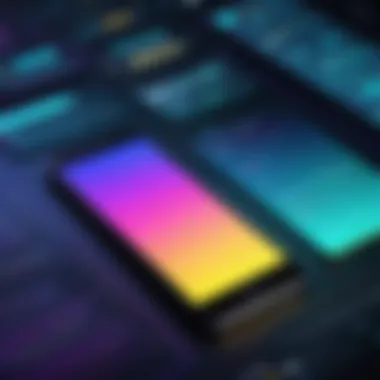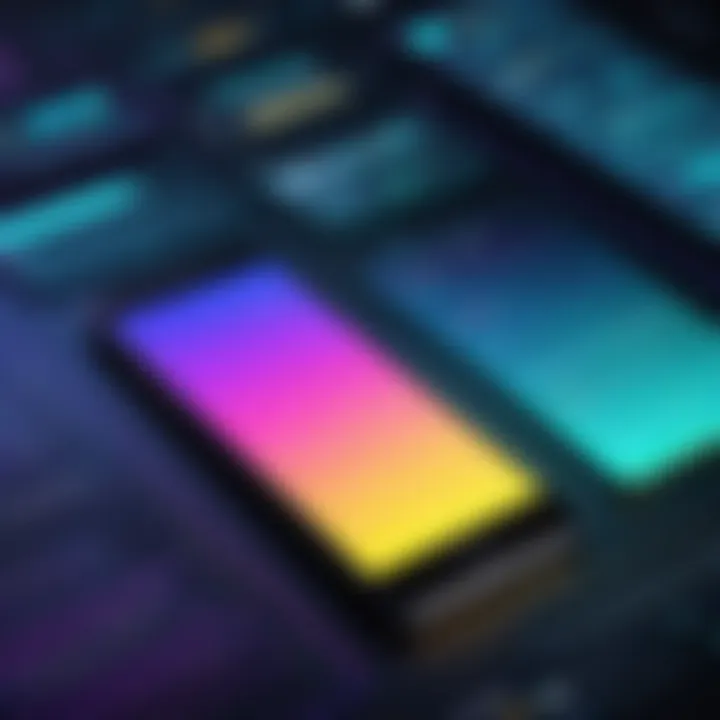Creating Your Own Snapchat Filter: A Step-by-Step Guide


Intro
In today’s visually driven world, the demand for unique and captivating digital experiences is high. Custom Snapchat filters allow users to express creativity and connect with their friends in innovative ways. With a few tools and some design knowledge, anyone can create a personalized filter that showcases their style. This guide will provide all necessary steps, focusing on technology, design, and the process for making your filter available to the Snapchat community.
Overview of the Technology
Snapchat operates on augmented reality technology for its filters. When you create a filter, you interact with their platform employing various graphical and coding techniques.
Key specifications
- Snapchat Lens Studio: This is the software you will use for filter creation. It's powerful and user-friendly.
- Camera Integration: Filters utilize the camera functionalities of smartphones, allowing real-time interaction.
- Geolocation Features: These filters can be set to appear in specific locations, enhancing usage for events or personal gatherings.
Unique selling points
Creating a Snapchat filter sets you apart. Users can share personalized experiences with friends, and there’s an opportunity for brands to enhance their marketing strategy through creative branding and local engagement.
Design and Build Quality
The design of your Snapchat filter is essential for its effectiveness and appeal. Consideration of material and usability is crucial to ensure your filter is engaging.
Material used
Digital assets like images, graphics, and animations are the core materials of your filter. Using high-resolution images will ensure clarity and quality on various devices. Familiarity with design software like Adobe Illustrator can be beneficial.
Ergonomics and usability
A DIY filter should be intuitive. This means the design should be simple, allowing users to understand quickly what to do. Always consider the user experience. If a filter is complicated, users may become frustrated and quickly abandon it.
"Great design is about making solutions accessible."
Epilogue
Preamble to Snapchat Filters
Snapchat filters have transformed the way users engage with their personal experiences. This section serves as a vital foundation for understanding why Snapchat filters matter, especially for those looking to create their own. The scope of this discussion extends beyond mere aesthetics; it delves into the significance of filters in digital identity, creativity, and social interaction.
Importance of Snapchat Filters
The primary function of filters is to enhance communication. Filters allow users to overlay graphics or effects on their images, thus expressing emotions or themes in a unique way. They can change the ambiance of a photo, making it more engaging and shareable. For instance, users can visually set a mood for their gatherings or celebrations through customized filters. This interactivity enriches the user experience on the platform.
In essence, they have evolved from novelty tools to powerful means of personal expression and branding. Users are not just passive consumers of content; they contribute actively by creating and sharing their filters. This engagement promotes creativity and encourages community building.
Benefits of Creating a Custom Filter
Creating a custom filter offers numerous advantages:
- Personalization: A tailor-made filter reflects individual style and preference.
- Brand Enhancement: For businesses, branded filters can elevate visibility and engagement, attracting potential customers.
- Event Promotion: Custom filters can commemorate specific occasions, enhancing memories.
Moreover, the process of creating a filter encourages learning new digital skills. Users gain familiarity with graphic design tools and the principles of user experience. This knowledge can be beneficial not only for creating filters but also for various other endeavors in the tech field.
Considerations and Challenges
While Snapchat filters offer exciting possibilities, the journey begins with understanding the requirements and limitations. Each filter needs to meet specific guidelines established by Snapchat. Failing to adhere to these can result in rejection during the submission process.
Additionally, design considerations such as color choices and readability must be taken into account to ensure the filter effectively communicates its message. Balancing creativity with technical constraints is essential.
In summary, this introduction outlines the significance of Snapchat filters and sets the stage for a detailed exploration of the process involved in their creation. By understanding the nuances of filters, users can unlock a powerful tool that enhances both personal and social experiences.
Understanding the Basics of Filters
Understanding the fundamentals of Snapchat filters is crucial for anyone interested in creating their own. Filters serve as an engaging way to personalize images and videos, adding a unique flair that resonates with both users and viewers. They transform the ordinary into something magical, enhancing user interaction and creating memorable experiences.
In this section, we will explore the different aspects of Snapchat filters. You will learn not only about what these filters are, but also the types available and how they can cater to different needs. Grasping these essentials will set the foundation for your filter-making journey.
What Are Snapchat Filters?
Snapchat filters are graphic overlays that users can apply to their photos or videos. They can modify the appearance of the image drastically—from adding playful graphics to changing the overall color scheme. Filters enhance user-generated content and are widely employed to foster creativity and engagement on the platform.
These filters can also highlight local events or promote businesses, making them a valuable tool for marketing. By understanding what Snapchat filters are, you can better appreciate their potential impact on social interaction and brand recognition.


Types of Filters
There are several categories of Snapchat filters. Each serves a unique purpose and offers different capabilities:
Geofilters
Geofilters are location-based overlays that users can access when they are in specific geographic areas. This type of filter is commonly used for events or particular neighborhoods.
The key characteristic of geofilters is their specificity; they only work in designated locations. For example, a wedding venue might have a unique geofilter that guests can use when they are present at the location.
This feature makes geofilters popular among businesses and event organizers, as it allows targeted engagement and enhances brand presence in the community. However, one downside is the limited audience reach outside the designated area.
Lenses
Lenses are augmented reality features that alter the user's face or surroundings in real-time. They use facial recognition technology to map 3D effects like masks, animations, and fun overlays directly onto the user’s image.
Lenses stand out because of their interactive nature. Users can engage with these lenses, creating a more immersive experience. This engagement is beneficial for brand campaigns that aim to go viral. However, developing a lens may require more technical skill compared to simpler filter options.
Custom Filters
Custom filters can be tailored for specific occasions, such as birthdays, graduations, or business promotions. Unlike geofilters, they do not always rely on location and can be made to suit personal preferences.
The unique feature of custom filters lies in their flexibility; they can incorporate logos, personalized texts, or illustrations that resonate with users. This customization provides brands and individuals with a unique way to express their identity. However, custom filters usually require a review by Snapchat for approval, which can delay their use.
Understanding these types of Snapchat filters, along with their specific characteristics, will help you decide the best route for your creative endeavors. Each type offers distinct advantages and potential limitations that can shape how you approach creating your filter.
Core Tools for Filter Creation
The process of creating a Snapchat filter requires the right tools. These tools not only aid in the design but also play a crucial role in ensuring the filter functions as intended. Having a solid grasp of these tools can make the difference between a mediocre filter and one that truly resonates with users. In this section, we will explore essential tools needed for filter creation and how they contribute to the overall success of your design.
Snapchat Filter Lens Studio
Snapchat Filter Lens Studio is the primary software for creating augmented reality experiences on Snapchat. This platform is vital due to its user-friendly interface and extensive range of features. Users can import 3D assets, manipulate images, and add various effects, making it a versatile tool. One of its significant contributions is real-time previews. This feature allows creators to see their filter in action before final submission. Moreover, Lens Studio updates frequently, offering new capabilities and keeping the design process fresh.
Graphic Design Software
Graphic design software is another essential aspect of filter creation. It allows users to create high-quality visuals for their Snapchat filters. Here are some popular graphic design tools:
Adobe Photoshop
Adobe Photoshop is well-known for image editing and graphic design. It's particularly beneficial for creating intricate designs. Its ability to handle layers offers flexibility, allowing for non-destructive editing. Users can apply various effects and adjustments that enhance the quality of the graphics imported into Snapchat. A unique feature of Photoshop is the vast array of plugins available, which can significantly expand its functionality. However, beginners may find its learning curve steep, which can be a disadvantage for new creators.
Illustrator
Adobe Illustrator specializes in vector graphics. This software is perfect for creating crisp and scalable designs. Its primary advantage is the ability to produce logos and icons that retain quality regardless of size. This characteristic proves useful for Snapchat filters, where users often want clear and sharp images. An important feature is the pattern-making tool, which allows designers to generate complex textures effortlessly. The downside may be its cost and complexity for someone not already familiar with vector-based software.
Other Alternatives
There are several alternatives to the industry standards of Adobe products. Options like GIMP provide a free platform for image editing, while tools like Inkscape are available for vector graphics. These alternatives are beneficial for those who want to explore filter creation without investing in expensive software upfront. They offer essential functionalities, although they may not match the advanced features of Adobe's products. Therefore, while they can serve the purpose, users must consider potential limitations in quality and usability.
"Choosing the right tools is essential for a smooth and effective filter design process."
The core tools for creating Snapchat filters are significant in shaping the final product. Understanding their strengths can streamline the design process and enhance creativity. When selecting tools, consider your skill level, budget, and specific design needs. By employing the right combination of software, your chances of producing an engaging filter increase substantially.
Key Design Considerations
When creating a Snapchat filter, careful design considerations are crucial. Filters are not just visual additions; they are tools for expression and communication. The effectiveness of your filter largely depends on the choices you make during the design process. Keeping these considerations in mind can enhance the user experience and ensure your filter resonates with its intended audience.
Defining the Purpose of the Filter
Before any design work begins, it's vital to define the purpose of the filter. Understanding why you are creating the filter shapes your design choices. Is it for a specific event, like a wedding or a birthday? Or is it for a brand promotion?
Having a clear intention will guide you in your design. A filter designed for a wedding will likely feature softer colors and romantic elements, while a promotional filter for a brand may incorporate bold logos and color schemes that align with the brand’s identity. This clarity fosters creativity and provides direction throughout the design process.
Choosing Colors and Themes
Colors and themes play a significant role in making your filter visually appealing and engaging. Choosing a color palette that aligns with the purpose can maximize impact. For example,
- Bright hues may convey energy and excitement, ideal for celebrations.
- Pastel tones often evoke feelings of calm and serenity, appropriate for events like weddings.
Themes also contribute to the overall vibe of the filter. Consider cultural significance and trends when selecting a theme. Research current popular colors and motifs on social media to ensure your filter stands out. Use tools like Adobe Color to find complementary colors and develop a cohesive color scheme.
Image Dimensions and Quality
Quality cannot be overlooked in filter design. Snapchat has specific image dimensions and quality standards that must be met for a filter to function properly. Filters should be designed at a resolution of 1080 x 1920 pixels to ensure they look crisp on all devices.
Important points to consider:


- Use vector graphics when possible. They maintain quality regardless of size adjustments.
- PNG format is preferable for transparency, allowing for a cleaner look.
- Test your design on various devices to ensure clarity and performance.
By focusing on these key design aspects, you create a foundation for a successful Snapchat filter. Consider these factors not as limitations, but as guidelines that enhance creativity and precision.
Creating the Filter
The process of creating a unique Snapchat filter is both creative and technical. This aspect of filter creation involves several critical steps that define the outcome and impact of your design. By understanding how to set up the necessary elements, add your graphics and text, and implement animations, you increase the chances that your filter resonates with users, thus enhancing user engagement. It is not simply about aesthetics; each decision directly affects how the filter is perceived and used in social situations.
Setting Up Your Canvas
Setting up your canvas is the first step in the filter creation process. This provides the foundation where your creative ideas come to life. The canvas size is typically determined by the type of filter you plan to create, whether it's a Geofilter or a Lens. For Geofilters, the recommended size is 1080 x 1920 pixels, while for Lenses, a more detailed setup might be necessary depending on the effects desired.
Before you start designing, it's important to ensure that you select the right dimensions to avoid awkward cropping later on. Use a transparent background for overlays, as it allows the filter to blend seamlessly with the user's Snapchat photos. Aim for high-resolution images to maintain quality across various devices. A well-prepared canvas makes reducing errors later much easier.
Adding Graphics and Text
After you have the canvas set up, the next step is to add graphics and text. Here, creativity can flourish. Use relevant graphics that resonate with your target audience. Think about the emotions or themes you want to convey. Fonts should be legible and appropriately styled; remember, Snapchat's audience appreciates clarity. Avoid clutter that can overwhelm users.
For adding text, placement is key. Ensure it does not obstruct the main subject of the photos where the filter will be used. Balancing text with graphics improves overall engagement and enhances the viewing experience. Using brand colors or themes can provide familiarity, which might encourage users to choose your filter more often.
Implementing Animations
Implementing animations is where you can add depth and interactivity to your filter. Animations attract attention and can make your filter more memorable. In Snapchat's Lens Studio, you have tools available to add these effects in a straightforward way. Consider using subtle animations, such as moving elements or changing colors over time, to enhance user experience without causing distraction.
While implementing animations, remember they should serve the purpose of enhancing, not detracting from, the user's experience. Excessive movement can lead to disorientation. Correctly timed animations can make a filter feel dynamic and engaging. It is not merely about making things move but about ensuring those movements resonate with what users express through them.
"A well-executed filter does more than simply modify images; it encapsulates a narrative that invites user participation."
In summary, creating the filter entails thoughtful planning and design. Each element, from the canvas setup to the addition of graphics and animations, plays a significant role in the final product. Engage with your audience visually and technically to maximize the impact of your Snapchat filter.
Testing Your Filter
Testing your filter is a critical stage in the filter creation process. It is necessary to ensure that your design works as intended before submitting it for public use. By rigorously testing, you can identify potential issues such as bugs, performance problems, and usability concerns that could affect the user experience negatively.
To achieve a polished final product, it's essential to engage in two primary testing steps: previewing in Lens Studio and beta testing with friends.
Previewing in Lens Studio
Lens Studio offers a preview feature that allows creators to see their filter in action before uploading it to Snapchat. This functionality enables you to verify the design elements, animations, and interactivity. You can directly access the preview mode within Lens Studio once your graphics and animations are in place.
When you preview your filter, pay attention to the following:
- Graphics Quality: Ensure that the images are sharp and clear.
- Response Time: Check that the filter reacts quickly to movements or interactions.
- Compatibility: View your filter on different device models, as performance may vary.
By spending time in this stage, you accumulate valuable insight and prepare for potential adjustments. It is better to troubleshoot issues in this environment than to deal with them after public release.
"Testing a filter before release is not just a precaution; it is a prerequisite for user satisfaction."
Beta Testing with Friends
After you feel confident with your initial testing, it can be beneficial to involve friends in the beta testing phase. Sharing your filter with a select group allows you to gather fresh perspectives on its functionality and appeal.
Consider these points when conducting beta testing:
- User Feedback: Ask your friends for detailed feedback on their experience. Consider questions like, "Did the filter perform as expected?" and "Were there any moments where it did not respond properly?"
- Diverse Audience: Select friends with varying levels of familiarity with Snapchat to obtain diverse insights. Some may see issues that others might overlook.
- Observe Usage: Watch how they interact with your filter; this can highlight unforeseen issues and help you refine design choices.
Testing your filter, both in Lens Studio and with a real audience, forms a strong foundation to ensure your final product is engaging and functional. This aspect cannot be underscored enough; thorough testing is imperative for a successful launch.
Submitting Your Filter
After putting significant effort into designing your Snapchat filter, the submission process is a crucial step that should not be overlooked. This phase ensures your custom filter reaches users in the broader Snapchat community. Proper submission not only validates your work but also allows others to enjoy and engage with your creativity. Moreover, following the submission guidelines can prevent unnecessary rejections which can hinder your filter from being available.
Reviewing Submission Guidelines
Before submitting your filter, familiarize yourself with the Snapchat submission guidelines. These guidelines detail what is needed for a successful submission. Factors such as appropriate content, image sizes, and geographical restrictions are critical to understand. Failure to comply could lead to a rejection, which means you must start from scratch. Here are some themes to keep in mind while reviewing the guidelines:
- Content Appropriateness: Ensure your filter adheres to Snapchat's community standards. Any offensive or inappropriate content can lead to immediate rejection.
- Design Specifications: Filters must meet specific size and format requirements, including pixel dimensions and file types. This ensures that the filter displays correctly across devices.
- Usage Rights: Confirm that you have the rights to use any graphics or images included in your filter. Improper usage can result in legal issues.
Reviewing these guidelines will save time and enhance your chances of a successful filter launch.


Uploading the Filter
Once familiar with the guidelines, the actual uploading process is straightforward. This step allows you to submit your filter to Snapchat for review. Here are the steps for uploading your filter:
- Open Snapchat Lens Studio: Launch the application where you created your filter, and ensure it is ready for upload.
- Sign In: Log in to your Snapchat account. You need to be signed in to upload any content.
- Select Your Filter: From the dashboard, choose the filter design you want to upload. Ensure you have saved the most current version.
- Follow Prompts: Follow the on-screen prompts to provide necessary details about your filter, like its name and description.
- Submit for Review: With all details filled out correctly, submit your filter. It will then undergo a review process by Snapchat's team.
"Submitting your filter is not just the end of a process; it opens doors to creativity and interaction among users."
After submission, be prepared for a waiting period as the review team evaluates your work. This evaluation can take anywhere from a few hours to several days, depending on volume and complexity. Patience is key here, as your effort could soon be rewarding.
Promoting Your Filter
Promoting your Snapchat filter is crucial for ensuring it reaches a broad audience. Creating a filter is just the first step; sharing it effectively can enhance its visibility and increase user engagement. The goal is not only to have friends use it but also to attract new users who might find your filter appealing. Effective promotion can lead to virality, turning your filter into a popular choice within the Snapchat community.
Sharing with Friends
One of the most straightforward ways to promote your filter is through direct sharing with friends. Snapchat makes this process user-friendly. When you create a filter, you can share it directly from the Snapchat app. This allows your friends to instantly access and use the filter. You can send it as a Snap, making it easy for them to apply it in their stories as well.
Additionally, consider hosting a small gathering or event where everyone can try out the filter. There is something engaging about a group experience, and it can spark interest in using the filter further. Asking your friends to share their photos using the filter on their social networks can multiply visibility.
Utilizing Social Media
Beyond direct sharing, leveraging social media platforms can help maximize your filter's reach. Using platforms such as Facebook, Instagram, or Twitter can drive more users to check out your filter. Create posts highlighting the unique features of your filter. You can also display sample images to showcase what users can create with it.
Consider creating a dedicated hashtag for the filter. Encourage users to include the hashtag in their posts. This expands the conversation surrounding your filter and aids in categorization. Engaging with users who post using your filter can also foster a community around it. Responding to comments and sharing their posts amplifies user engagement.
"Promotion is not just about visibility; it's about creating an experience that users will want to share."
Evaluating the Success of Your Filter
Evaluating the success of your Snapchat filter is crucial. It goes beyond just creating and promoting it. After you release your filter into the wild, understanding how it performs can provide valuable insights. This evaluation helps to gauge user engagement, gather feedback, and make informed adjustments. Each successful filter not only enhances user experience but also builds your brand identity within the Snapchat community.
Analyzing User Engagement
User engagement is a primary metric that reflects how well your filter resonates with its audience. Analyzing it requires careful observation of various data points. Two specific insights can be garnered through Snap Map Insights and User Feedback.
Snap Map Insights
Snap Map Insights allows you to view where users are interacting with your filter.
- The key characteristic of Snap Map Insights is its ability to visualize user interactions across geographic locations.
- This feature is beneficial because it indicates the regions where your filter is most popular. You can also determine peak usage times.
A unique feature of Snap Map Insights is its real-time tracking capability, offering immediate feedback about user engagement.
- The advantage of this is that you can quickly see patterns or trends.
- A disadvantage, however, is that it may not reveal the deeper reasons behind user interactions, such as why they are engaging with your filter versus others.
User Feedback
User Feedback enables direct conversations with your audience. It is an essential aspect of understanding overall satisfaction with your filter.
- The key characteristic of User Feedback is its insightful nature. It gives specifics about what users like or dislike about your filter, making it a popular method for enhancement.
- Collecting feedback can be done through social media, direct messages, or even in-app surveys.
User Feedback has the unique feature of providing qualitative data. This data can reveal emotions and perceptions that numbers alone may not capture.
- The advantage of qualitative data is that it can lead to new ideas for design changes or similar projects. Conversely, a disadvantage is that feedback can sometimes be vague or overly critical, lacking constructive suggestions.
Making Iterative Improvements
Making iterative improvements is the natural next step after assessing user engagement and feedback. The goal of this process is to continuously enhance your filter based on insights gathered. Small adjustments can often lead to significant increases in user satisfaction. Regular updates keep the filter relevant, allowing you to engage effectively with your audience and improve their experience.
Closure
The conclusion serves as a crucial element in the overall framework of this article. It provides a concise summary of the intricate process involved in creating a Snapchat filter. For readers who have journeyed through various sections, this recap helps to consolidate their understanding, reinforcing key points discussed previously.
Recap of the Process
Creating a Snapchat filter consists of several interlinked steps. First, users need to understand the various types of filters available, such as geofilters and lenses. Following this, the core tools like Snapchat’s Lens Studio and graphic design software must be recognized and utilized. Key design considerations focus on the filter’s purpose, color schemes, and the technical aspects of image dimensions.
Once these elements are in place, one can effectively create the filter by setting up a canvas, adding graphics or text, and even implementing animations. It is crucial to test the filter extensively before submitting it. Through previewing in Lens Studio and conducting beta tests with friends, necessary adjustments can be made. After testing, one reviews the submission guidelines, uploads the filter, and begins the promotion process. Evaluating user engagement through Snap Map insights and feedback is essential for iterative improvements.
Final Thoughts
Creating a custom filter on Snapchat offers a unique avenue for self-expression and creativity. This process not only demands technical skills but also a deep understanding of design principles.
As technology evolves, staying ahead with innovative content can be beneficial for visibility within the Snapchat community.
It's essential to approach this entire undertaking with a blend of creativity and analytical thinking. Engaging with the audience, evaluating feedback, and making improvements can ultimately lead to a successful filter that resonates with users. Remember, the journey of crafting a filter does not end with submission; it is a continuous process of learning and adapting.







